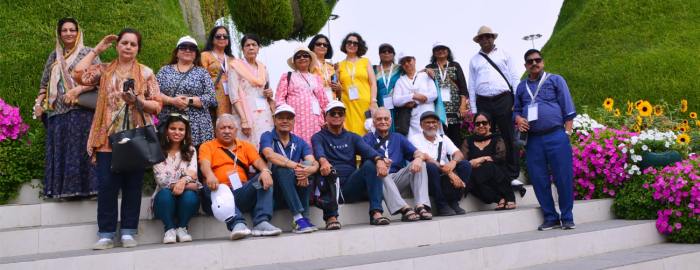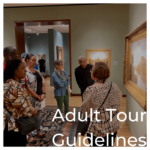Senior Citizen Group Tours offer a compelling blend of adventure, camaraderie, and ease for the discerning traveler. This burgeoning sector caters to a demographic increasingly seeking enriching experiences, carefully curated to accommodate specific needs and preferences. From meticulously planned itineraries to accessible destinations and engaging themes, these tours redefine the senior travel landscape, offering a gateway to exploration and connection.
This guide delves into the multifaceted world of senior citizen group tours, examining everything from planning and logistics to marketing strategies and pricing models. We’ll explore popular destinations, discuss accessibility considerations, and provide actionable insights for those interested in creating or participating in these enriching journeys. The goal is to illuminate the potential of this growing market and offer a roadmap for successful implementation and participation.
Marketing & Outreach

Reaching the lucrative senior travel market requires a multi-pronged approach that leverages both traditional and digital channels, carefully tailored to resonate with the specific needs and preferences of this demographic. Effective marketing must emphasize trust, value, and ease of access.
Three Distinct Marketing Strategies for Senior Citizen Group Tours
Targeting senior citizens effectively necessitates diverse strategies. A singular approach is insufficient to capture the varied preferences and access points of this demographic. The following three strategies offer a comprehensive approach.
- Targeted Print Advertising in Senior-Focused Publications: Print remains a powerful medium for reaching seniors who may be less digitally inclined. Advertisements in publications like AARP The Magazine, regional senior living guides, and newspapers with significant senior readership offer a direct and impactful method of reaching the target audience. These ads should feature large, clear fonts, high-quality images depicting happy seniors on tours, and straightforward messaging highlighting ease of travel and companionship.
- Strategic Partnerships with Senior Centers and Retirement Communities: Building relationships with local senior centers and retirement communities provides direct access to a concentrated pool of potential customers. This involves offering presentations, distributing brochures, and potentially organizing exclusive tour previews for residents. Building trust through personal interaction is crucial in this strategy.
- Digital Marketing Focused on Accessibility and Ease of Use: While seniors may be less digitally native than younger generations, many are active online. A user-friendly website with large fonts, clear navigation, and easily accessible booking options is essential. Targeted online advertising on platforms frequented by seniors, with a focus on accessibility features, can also yield significant results. This includes employing simple language and clear calls to action.
Benefits of Social Media for Promoting Senior Citizen Group Tours
Social media, despite its association with younger demographics, presents a valuable tool for reaching seniors. However, the approach must be tailored to their preferences.
Platforms like Facebook offer targeted advertising options allowing for precise demographic targeting (age, location, interests). Visual content, such as photos and videos showcasing past tours and happy travelers, is particularly effective. Furthermore, Facebook groups dedicated to senior activities or travel can provide organic reach and build community. Testimonials and reviews from past participants can build trust and credibility.
The key is to create easily digestible content, using large fonts and clear, concise messaging. Regular, consistent posting is crucial for maintaining engagement.
Print Advertising vs. Online Advertising for Senior Citizens
The effectiveness of print versus online advertising hinges on the specific segment of the senior population being targeted.
Print advertising, specifically in targeted publications, offers a tangible and trustworthy experience. Seniors appreciate the tactile nature of print and the familiarity of established publications. However, the reach is geographically limited and the cost-per-impression can be higher than online advertising. Online advertising, when executed correctly, can offer a broader reach and more precise targeting, but requires careful attention to website design and accessibility to cater to the needs of older users.
A blended approach, leveraging the strengths of both mediums, is often the most effective strategy.
Sample Marketing Materials
Brochure Description: “Discover the World with Ease: Join our expertly guided group tours designed specifically for seniors. Enjoy worry-free travel with comfortable accommodations, engaging itineraries, and the companionship of like-minded individuals. Let us handle the details while you savor unforgettable experiences.”
Social Media Post (Facebook): Image: A group of smiling seniors enjoying a scenic view during a tour. Caption: “Unforgettable memories await! Explore [Destination] with our senior group tour. Comfortable travel, amazing sights, and new friends. Book your adventure today! [Link to website]”
Accessibility & Inclusivity

Catering to the diverse needs of senior travelers is paramount for creating memorable and enriching group tour experiences. Failure to address accessibility and inclusivity can lead to exclusion and potentially negative experiences, undermining the overall success of the tour. A well-planned and executed tour proactively anticipates and accommodates the physical limitations and health concerns frequently encountered by this demographic.
Addressing Physical Limitations and Health Concerns
Senior travelers often present a wide range of physical limitations and health concerns. These can include reduced mobility due to arthritis, joint pain, or other musculoskeletal issues; impaired vision or hearing; cardiovascular conditions limiting stamina; and cognitive impairments affecting memory or orientation. Understanding the potential for these challenges is critical for developing inclusive tour itineraries and support systems.
For example, a tour focusing on strenuous hiking would be inappropriate for a group with mobility limitations, whereas a tour emphasizing gentle walks and accessible sites would be more suitable. Similarly, clear and concise communication, utilizing visual aids and amplification systems where necessary, is crucial for addressing visual and auditory impairments.
Incorporating Accessibility Features into Tour Planning and Execution, Senior Citizen Group Tours
Incorporating accessibility requires a holistic approach starting with the initial tour design. This includes selecting accessible venues, transportation, and accommodation options. Itineraries should be designed to minimize strenuous activity and maximize rest periods. The use of accessible transportation, such as wheelchair-accessible buses or vans, is essential. Tours should also incorporate ample time for restroom breaks and allow for flexibility in the schedule to accommodate individual needs.
Pre-tour communication should explicitly Artikel accessibility features and provide opportunities for participants to communicate their specific needs. On-site support, such as trained staff familiar with assisting individuals with mobility aids or other disabilities, should be readily available.
Accommodations and Transportation Options
A range of accommodations and transportation options cater to diverse accessibility requirements. Hotels should offer accessible rooms with features such as roll-in showers, grab bars, and wider doorways. Transportation providers offering wheelchair-accessible vehicles are readily available in many locations, though advance booking is often necessary. Consideration should also be given to the availability of accessible restrooms and other amenities at all planned locations.
For example, choosing restaurants with ramps and accessible seating arrangements ensures that all participants can comfortably enjoy meals. Similarly, selecting tour destinations with well-maintained pathways and minimal inclines facilitates easier mobility for those with walking difficulties.
Checklist for Inclusive Tour Experiences
A comprehensive checklist is crucial to ensure inclusivity and a positive experience for all participants. This checklist should include: confirmation of accessibility features at all venues and accommodations; detailed information about transportation options, including accessibility features; clear communication of the itinerary and any potential physical challenges; provisions for rest periods and flexible scheduling; readily available assistance from trained staff; and mechanisms for addressing participant concerns or requests.
Pre-tour questionnaires can help gather crucial information about participants’ individual needs and preferences, allowing for tailored support and modifications to the tour plan. This proactive approach ensures a safe, comfortable, and enjoyable experience for everyone.
Pricing & Value Proposition: Senior Citizen Group Tours
Pricing senior citizen group tours requires a delicate balance between profitability and accessibility. Factors such as destination popularity, travel dates (peak vs. off-season), the level of luxury offered, and the included services significantly impact the final cost. Understanding these variables is crucial for creating a competitive and appealing package.Factors Influencing PricingSeveral key elements determine the cost of a senior citizen group tour.
Transportation costs, encompassing airfare, ground transportation, and potential transfers, often constitute a substantial portion of the total price. Accommodation choices, ranging from budget-friendly hotels to luxury resorts, also play a vital role. The inclusion of guided tours, excursions, entrance fees to attractions, and meals directly influence the overall cost. Finally, operational expenses, such as staff salaries, insurance, and marketing, must be factored into the pricing structure.
Seasonal fluctuations, particularly in popular destinations, can also lead to price variations.
Comparison of Pricing Strategies
Three prominent tour operators – Globetrotting Seniors, Silver Linings Travel, and Mature Adventures – demonstrate diverse pricing approaches. Globetrotting Seniors focuses on premium, all-inclusive packages, reflecting a higher price point but minimizing unexpected costs for participants. Silver Linings Travel offers a wider range of packages, from budget-conscious options to more luxurious choices, catering to a broader spectrum of budgets.
Mature Adventures emphasizes value-driven tours, prioritizing cost-effectiveness while still ensuring a comfortable and enjoyable experience. These varied strategies highlight the need for tour operators to define their target market and adjust pricing accordingly.
Sample Pricing Structure
Let’s consider a 10-day escorted tour to Italy for a group of 20 seniors.
| Component | Cost per Person | Justification |
|---|---|---|
| Airfare (round-trip) | $1,200 | Based on average off-season fares from a major US city to Rome. |
| Accommodation (9 nights, double occupancy) | $900 | Mid-range hotels with convenient locations and senior-friendly amenities. |
| Transportation (ground transportation, transfers) | $300 | Includes private coach transportation between cities and airports. |
| Guided Tours & Excursions | $600 | Comprehensive itinerary featuring historical sites, cultural experiences, and regional highlights. |
| Meals (breakfast daily, select lunches & dinners) | $400 | Mix of included meals and opportunities for independent dining. |
| Entrance Fees & Activities | $200 | Covers admission to museums, attractions, and optional activities. |
| Tour Leader & Support Staff | $300 | Experienced tour leader and local guides providing assistance and insights. |
| Total Cost per Person | $3,900 |
Highlighting the Value Proposition
To attract potential customers, emphasizing the unique value proposition is crucial. This involves clearly communicating the benefits beyond just the price. For instance, highlighting the convenience of all-inclusive packages, the expertise of experienced tour leaders, the focus on accessibility and inclusivity, and the opportunity to connect with like-minded individuals creates a compelling narrative. Marketing materials should showcase stunning visuals of the destinations, testimonials from previous participants, and emphasize the peace of mind offered by a well-organized and supported travel experience.
Offering early-bird discounts or group discounts further enhances the appeal and affordability. The focus should be on providing a stress-free and enriching travel experience tailored to the specific needs and preferences of senior citizens.
The success of senior citizen group tours hinges on a meticulous approach to planning, a deep understanding of the target demographic, and a commitment to delivering exceptional value. By carefully considering accessibility needs, crafting engaging itineraries, and implementing effective marketing strategies, operators can create unforgettable experiences that foster independence, connection, and lasting memories. The potential for growth in this market is significant, driven by an aging population with a thirst for adventure and a desire for enriching travel experiences.
Careful attention to detail and a customer-centric approach are key to unlocking this potential.

